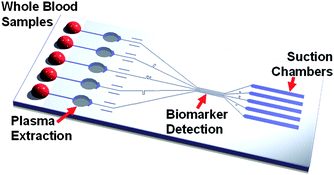Stand-alone self-powered integrated microfluidic blood analysis system (SIMBAS)†
Abstract
We present a self-powered integrated microfluidic blood analysis system (SIMBAS) that does not require any external connections, tethers, or tubing to deliver and analyze a raw whole-blood sample. SIMBAS only requires the user to place a 5 μL droplet of whole-blood at the inlet port of the device, whereupon the stand-alone SIMBAS performs on-chip removal of red and white cells, without external valving or pumping mechanisms, followed by analyte detection in platelet-containing plasma. Five complete


 Please wait while we load your content...
Please wait while we load your content...